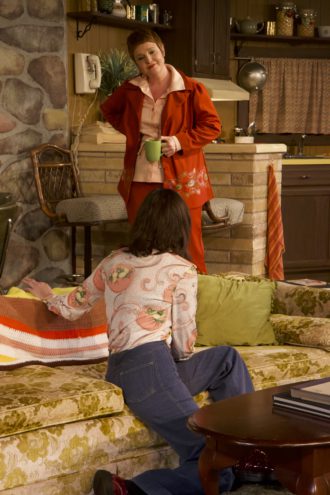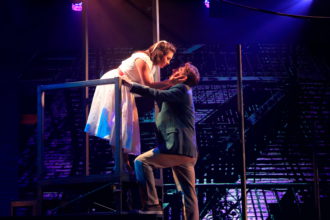Nearly 90 years after the Vagabond Players first organized in Western North Carolina and over 70 years since they took root at Flat Rock Playhouse, many attendees don’t realize that the Henderson County nonprofit is a full, producing theater.
“They think that we’re a presenting theater and the show just shows up. The actors come in ready, the set comes in ready, the costumes are just there and they’re done — but they don’t,” says Adam Goodrum, FRP production manager.
“We start from the ground up with the show. We go to New York [City], we audition the cast, we go and hire our musicians, and we are charting the music for our musicians. We’re designing the costumes, the lights, the sounds, the set.”
While the general misconception persists that, in Goodrum’s words, “if you’re not on Broadway, that work just gets shipped to you,” it also discounts the meticulous work of local craftspeople who ensure that each production looks great and conveys the director’s vision.
Xpress recently spoke with behind-the-scenes players from three area theaters about what’s involved in getting sets, props and costumes to the stage in order to sustain the companies throughout each season.
Set it up
The first thing most attendees notice when they walk into a theater is the set. And Julie K. Ross, N.C. Stage Company scenic designer, counts on verbal feedback to tell if she’s succeeded in her aims.
“You usually get comments right away. They’re like, ‘Whoa! Cool!’ or ‘Wow! I can’t believe they did that,’” she says. “When I go see a show, I like to sit in the back and listen for what people say — which is awesome because it’s totally unfiltered. You go both ways, but most of the time you’re pleasantly surprised at people’s reactions.”
In cases where sets need to be built — which Ross says is most of the time — the technical director oversees the construction aspect. Ross says N.C. Stage’s go-to TD, Sylvia Pierce (who doubles as props artist), has good carpentry skills and decides the best way to build something after Ross hands in her overall design.
“When I’m designing them, I try to keep in mind similar-sized walls so we’re not building fresh each time,” Ross says.
For example, the rock wall from the February staging of Incident at Our Lady of Perpetual Help was originally carved for the March 2023 production of Vanya and Sonia and Masha and Spike. And the bar area, featuring more carved stones, was from the March 2017 staging of Other Desert Cities.
Repurposing scenery gives Ross more time to round out the set, and she first consults a photo inventory to see what furniture and props N.C. Stage has in its modest storage.

“Oftentimes, I’ll start the design process a month or two before the actual show. And in that time, I’m constantly scouring Craigslist and Facebook Marketplace,” Ross says. “Sometimes, things pop up, and they’re really cheap, which is definitely in our wheelhouse. But if you don’t move fast enough, you miss out on it, and it’s like, ‘Oh, crap! What are we gonna do now?’”
In a recent pivot, Ross missed out on a plaid couch that felt perfect for Incident at Our Lady of Perpetual Help but found a green one in Rutherfordton. It fit with the show’s 1970s aesthetic, but using it meant shifting the show’s color palette to match it.
Jill Summers, production manager at Asheville Community Theatre, likewise uses as much stock scenery as possible and will construct any other needed elements from scratch. She’s usually able to pull furniture, appliances or soft goods such as curtains from the theater’s own collection or find what she needs at the local thrift stores, particularly the Asheville Area Habitat for Humanity ReStore.
“I have also been known to just build and paint re-creations if I can’t find what I want — upright pianos, cast iron stoves, etc.,” Summers says. “If I need something very particular, I’ll reach out to theaters we have relationships with that may have done the production recently or might have the item I need — or can point me toward someone who does. Each show presents a unique challenge, so I spend a lot of time researching materials or watching YouTube videos so I can create my own.”
Rock solid
As FRP production manager, Goodrum is in charge of everything theatergoers see on stage — except the actors.
“That’s all the scenery, the props, the paints, the costumes, the lights, the sounds,” he says. “I’m hiring the team, I’m managing the team, I’m managing the spaces, calendars, the rehearsal calendars. When people are coming, when people are going and all of the budgets to go along with that.”
FRP produces a year in advance, but while the leadership team is already working on the 2025 season, Goodrum’s team starts the designing process around October for the first show in April.
“Then my team — the TD who’s in charge of building the sets and the props and the painters — they’re going to get design from our senior designer before the show opens. So that gives them about 10 weeks to fully produce the show: build, paint and find all the items that they’ll need,” he says.
The TD sources from a variety of places, depending on what the particular show requires. Productions that call for a lot of wrought iron or metal structures rely on local steel yards, particularly Jackson Steel. Lumber sources depend on who has the best price and inventory at the time, which often finds FRP pulling from Home Depot and Lowe’s but also downtown Hendersonville’s Builders FirstSource.

FRP has a 5,000-square-foot storage facility near the Hendersonville Airport for its larger props, such as couches, tables, chairs, desks and other objects that are too bulky to store on campus. If the theater doesn’t have an item for a show with a contemporary setting, it will turn to Amazon or Walmart. For older items, FRP has maintained strong relationships with area consignment and antique stores, from whom the theater will purchase pieces or figure out other arrangements.
“A lot of times, if it’s a dresser or a hutch or a desk that we don’t want to buy because we just don’t need more of them, they’ll let us borrow it,” Goodrum says. “It’ll be on our stage for the four weeks, and then we’ll give it back to them. And they’ll get a little shoutout in the playbill saying, ‘Thank you.’”
Once a show ends, practically everything goes back into storage, including stock items like walls, platforms and stairs, which get reused and painted over. And pieces less likely to be used often find new homes with other area theaters and high schools or enjoy new lives at FRP.
“Most of the things we build, if we know we don’t need it again, we’re going to build it in a way we can take it apart and reuse the raw material of it,” Goodrum says. “Very, very little goes in the trash. If it’s metal and we’re done with it, we’ll take it to a scrap yard and we’ll recycle it just to get some money back for it.”
All in the details
When it comes to finding props to help round out Ross’ vision at N.C. Stage, Pierce first starts looking in the easiest place: her house.
“I’m a theater person, so I own everything from antiques to tools to … I have so much stuff,” says Pierce, who’s been working in the industry for over 50 years.
At this early juncture, she also consults friends and professionals with a range of in-house holdings, as well as the inventories at N.C. Stage and ACT. Then it’s time to search beyond that bubble and see what Habitat for Humanity ReStore has. For remaining objects, Pierce combs Facebook Marketplace and goes to private sellers.
“And then when I’m done with all of that, if I have to, I will go online,” she says, favoring Etsy and other marketplaces over Amazon.
Furniture props are usually dictated by the set designer, and Pierce tries to get as close to Ross’ vision as possible. But each show’s director has a lot more say in the hand props, because they impact how a scene is blocked.
“You get paid to buy cool stuff, and you get paid to actually get the character in your brain and go, ‘What’s this person going to do?’“ Pierce says. “And I’m usually pretty spot on, and very, very few things get rejected, which is wonderful. Sometimes it’s just like, ‘Oh, we took it in a different direction — we need that.’ And then I go change it.”
If she’s unable to find what she wants, Pierce will build a prop. Here, as with other aspects of her job, she holds herself to the highest standards.

“If I give someone a built prop, it better not break. And that’s why, being a carpenter for 45 years, mostly I overbuild the crap out of things so they don’t break,” she says. “But I love building props because I still get to be creative.”
Working so far ahead keeps FRP from scrambling to find rare and unusual items as opening day nears, but Goodrum recalls several times that required going beyond the usual sources.
“We did a show called Chasing Rainbows: The Road to Oz, which was the story of Judy Garland before [The] Wizard of Oz, and we needed ruby slippers made — which were rhinestone slippers — and nobody in America still did that work by hand,” he says.
“We actually had a cobbler out of London make them for us. So, dealing with that and the exchange rate and the time difference — and getting them done in time by somebody that normally would spend years on making shoes like that was fun. The bonus is we had an outside producer on that show, so they kind of handled the majority of that.”
Also for Chasing Rainbows, Goodrum says the show’s director was determined to use the same custom-built 1912 Model T Ford convertible that was used in the original Broadway production of Ragtime. She had access to the vehicle — which Goodrum describes as a cross between a classic car and a golf cart — and figuring out how to transport it to and from the FRP stage proved challenging yet rewarding.
Fashion forward
Goodrum says FRP has roughly 1,000 square feet of costume storage on campus for “more everyday style costumes.” And in its 5,000-square-foot storage facility, he estimates 25% is occupied by costumes.
“It’s more the period ball gowns, large dresses, our furs — stuff that we don’t need every day,” Goodrum says. “But if the show is a period show and we have it, we’re gonna pull it, we’re gonna use it and we’re gonna reuse as much as we can.”
Vintage wear is sourced from local thrift and secondhand stores, and Goodrum notes that eBay has been particularly helpful for finding items for this summer’s productions of The Shawshank Redemption, Cabaret and Jersey Boys, each of which occur in the 1930-60 zone. For shows that take place before the early 20th century, such as the 1820s-set Amadeus, clothing becomes far more difficult to find, prompting the FRP to make them.
“We’ll go out to fabric stores and down to Atlanta to some of the large fabric stores and start to source and build from scratch,” Goodrum says.
New items for modern-day shows are purchased from Amazon and various department and outlet stores. But even never-worn items first go through some form of transformation before opening night.
“Everything that goes on our stage got touched, at some point, by the costume shop,” Goodrum says. “It may have gotten distressed — because a brand-new pair of blue jeans is going to look weird on stage, especially for somebody that’s had them for a while — or they’re going to add a different way to button it up.”

Velcro or snaps are frequently substituted for buttons or zippers to help with quick changes of shirts and pants. Tory Depew readily employs such handy methods in her contract work as a costumer designer with N.C. Stage. And as director of the School of Stage and Screen at Western Carolina University, she’s rented costumes from FRP and vice versa. With N.C. Stage, which has a small costume stock, Depew mostly pulls from her collection at school and buys fabric to make original pieces. But she occasionally uses established resources like the Oregon Shakespeare Festival, which has its entire costume inventory online.
“If you ask me for something, I probably know where on the internet to source that — or that it can’t be sourced,” Depew says. “For Witch, which I just did at N.C. Stage, I knew that that kind of Jacobean clothes and what I had in mind was not something that I could buy. I knew my stock at school didn’t have them, and I knew N.C. Stage didn’t have it. So, I made all of those clothes. And I don’t normally build that much.”
Depew sources some materials from JOANN Fabric and Crafts in Asheville and Foam & Fabrics Outlet in Fletcher. However, she mostly orders online, though she notes that those distributors are drying up, which makes navigating them more difficult than usual.
“The trick with buying online is you just have to have a really good background in fabric to know what you’re looking at. Like, ‘Is this going to be the appropriate weight, feel, flow, type, drape, color? What am I looking at? What are the words about this fabric? When they say jacquard, do they really mean brocade?’” she says.
“You have to really read between the lines and figure out what you’re looking at so that you get what you think you’re going to get — or have the time to order swatches and then make choices.”
While it’s essential that the actors have what they need and that her costumes fit with the director’s and scenic designer’s visions, Depew also relies on personal pride to know that she’s done a good job. Like Ross, she enjoys watching each show as an audience member and gauging the reactions of those around her, but usually waits until the production’s second week to give herself some distance.
“You get to see the show from a perspective that you don’t have when you’re watching it in tech,” she says. “You can also sometimes measure [success] by whether those people want to work with you again.”




Before you comment
The comments section is here to provide a platform for civil dialogue on the issues we face together as a local community. Xpress is committed to offering this platform for all voices, but when the tone of the discussion gets nasty or strays off topic, we believe many people choose not to participate. Xpress editors are determined to moderate comments to ensure a constructive interchange is maintained. All comments judged not to be in keeping with the spirit of civil discourse will be removed and repeat violators will be banned. See here for our terms of service. Thank you for being part of this effort to promote respectful discussion.